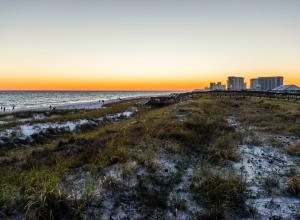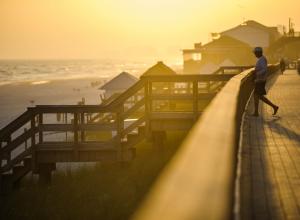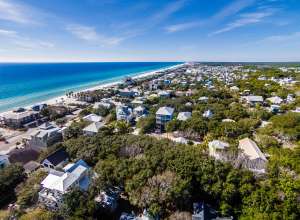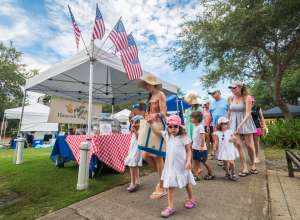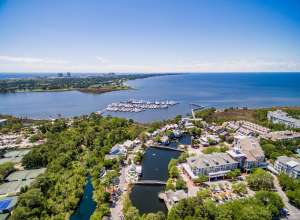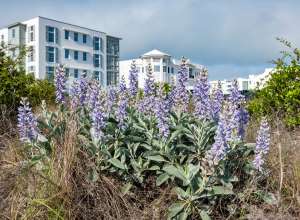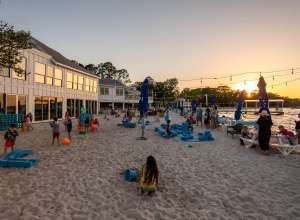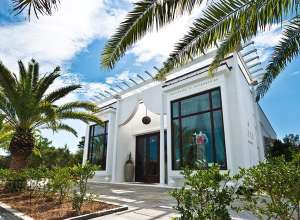Story
Coastal Dune Lakes Documentary - Australia’s Great Lakes Part II: Smiths Lake
December 30, 2014 by Nic Stoltzfus

The next day we woke up around six in the morning and headed down to Nelson Bay, roughly a 45-minute drive south from the farmhouse. Here we planned to take a helicopter and fly over the lakes to get some aerial shots. Dad told the pilot he wanted to film the Myall Lakes system and Smiths Lake.
 Les Cheers contemplating a rainbow overlooking Smiths Lake.
Les Cheers contemplating a rainbow overlooking Smiths Lake.
The Myall Lakes system is a collection of three interconnected lakes that eventually flow into Port Stephens. Myall Lake is the northernmost and freshest of the three lakes; they get more and more estuarine/salty as the water heads further south into the Port. Boolambayte Lake is saltier than Myall Lake and Boombah Broadwater is the saltiest of the three.
Think of the Myall Lakes system as a snake that has swallowed two big eggs and a horseshoe. Beginning with the snake’s tail, Myall Lake is the first egg that narrowly connects to the swallowed horseshoe, Boolambayte Lake, which connects to the last egg, Boombah Broadwater. After this, the Myall River snakes around a bit before the river mouth opens into a delta at Port Stephens.
Smiths Lake is a smallish egg-shaped lake nestled between the Myall Lakes system to the south and Wallis Lake to the north.
It was an overcast and misty morning as we drove down, and I was unsure whether we would be able to do a fly-over. By the time we arrived at the helipad the fog had cleared and what began as a foggy Friday had become a crisp winter day. Our pilot, John Herrick, checked with the Australian Royal Air Force to see if we were cleared for a fly-over, but they told John they were doing military training over the lakes and we wouldn’t be able to go up today.
We rescheduled for tomorrow and headed back north to Smiths Lake to meet up with the Cheers family. We arrived a little after one in the afternoon and were greeted by Kath, the matriarch and family historian. She introduced us to her husband, Les (pronounced Lars, like Owen Lars from Star Wars), her son Mike, and his wife and daughter. Les is a fourth generation fisherman in this area and Mike is following in his footsteps.
Kath invited us into her home and showed us around. On her walls hung pictures by a photographer who came in and shot Mike and Les working, one Urs Buhlman. We then joined her at the dining room table and she offered us tea and vickies (cookies).
Les grabbed a beer from the fridge, popped it open, and began telling us stories.
He told us a story about Wallis Lake, famous for Sydney Rock oysters. In the late ‘90s there was a Hepatitis A outbreak from pollution in the lake, which caused a tainted-oyster related death and resulted in national news coverage. Because of this, there is now more regulation of the lakes.
He told us how he once got $10,000 (Australian) for a yellowfin tuna. When the purchasers came to pick up the tuna they treated it like a fragile handcrafted vase. The fish was gently wrapped, iced down, and shipped to Tokyo to be sliced and served at the finest sushi restaurants in Japan.
He talked about what they are doing to improve their business: Most commercially sold fish in Australia now have a QR code on them that, when scanned, shows where the fish was caught and who caught it. So, for Les’ yellowfin tuna it would show that it was caught in the Great Lakes Region of New South Wales and beside that would be a picture of Les describing him as a fourth generation fishermen.
Les told us that Smiths Lake is manually opened and that the reason people dig out the sandbar between the lake and the Tasman Sea is to keep fish populations in the lake healthy.
“Nearly everything that goes to sea has got to spawn. If the lake doesn’t open the spawn is wasted. Got a couple of species that actually spawns on the lake here. And the area is always full of fish. Grandfather caught a ton of fish and we’re still catching a ton of fish…” He shared with us stories about how they have been opening this lake for decades and how, when he was a boy, he remembered going to the sandbar with his grandfather on a Sunday afternoon, meeting up with a group of other fishermen, and, with their church clothes on, shoveling out a ditch from the lake to the sea—a distance of about 20-30 yards. Les told us that the water slowly trickled through the small canal at first, but by Monday morning it had become a wide stream about a hundred meters across, flowing to the ocean.
After he finished his drink we drove down to the boat landing and headed out on the Cheers’ fishing boat, puttering towards the sandbar. Dad set up to film a timelapse and a winter storm formed east of us, pouring rain over the Tasman Sea as it rolled our way. A rainbow appeared overhead and we snapped some shots as we turned back to the boat landing to avoid the approaching downpour.
 Mike and Les Cheers’ fishing boat; they are putting in at Smiths Lake.
Mike and Les Cheers’ fishing boat; they are putting in at Smiths Lake.
I looked around the lakes and began to make mental comparisons of the lakes here and the ones we have in Florida.
The lakes in Australia are much larger. Smiths Lake, the one we were currently motoring through, has a surface area of roughly 4 square miles—compare this to Lake Powell, the largest coastal dune lake in Florida, which has a surface area of less than half a square mile. All the other coastal dune lakes in Florida are considerably smaller. Wallis Lake, just to the north of Smiths Lake is the heavyweight—when full it is around 40 square miles. In the the Myall Lakes system, Myall Lake rings in at around 22 square miles, Boolambayte Lake is close in size to Smiths Lake at around 4 square miles, and Boombah Broadwater stretches to around 9 square miles.
And the colors are different. Here, there are more earth tones, muted. The sand wasn’t as electric bright as ours is in Florida, but blends in with the rocky shoreline.
With the large scale and earthy colors, the lakes feel ancient and weatherworn—like the wizened tree-spirits from the Lord of the Rings, the ents. Rocky coastline, rolling mountains and deep-green forests call into the word often associated with landscapes of such grandeur: majestic.
 An aerial view of Smiths Lake.
An aerial view of Smiths Lake.
 Les Cheers looking out at Smiths Lake while standing at the sandbar.
Les Cheers looking out at Smiths Lake while standing at the sandbar.
Our lakes in Florida are small and brightly colored, fresh and puckered up like cherubs wrapped in a pastel paisley blanket, sparkling with youth.
The rumble of the motor clicked off and I snapped out of my daydream; we loaded our gear back into our SUV, said goodbye to the Cheers, and traveled back to Boolambayte.
[_______________
SoWal Note - we were so intrigued by Nic's post we had to start planning a trip to Smiths Lake in the Great Lakes area. We contacted the local tourism board and immediately felt a kiship to the area. The top image is from their archive. For more info and to plan your own visit, go to www.greatlakes.org.au | www.facebook.com/greatlakesnsw | www.instagram.com/greatlakesnsw.


